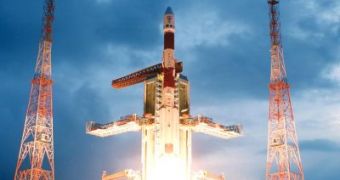The Indian space agency has announced that it terminated its Chandrayaan-1 mission to the Moon on Saturday, 14 months ahead of schedule. Launched last October, the orbiter had been revolving around Earth's natural satellite at an altitude of about 200 kilometers (124 miles), then it began to show signs of errors on April 26th, and the troubles just kept on multiplying from then on. Everything ended on Saturday, when mission controllers completely lost contact with the probe. A day later, on Sunday, they were left with no choice but to announce the mission a failure, the BBC News and Space report.
The Indian Space Research Organization (ISRO) was operating Chandrayaan-1. The probe featured five Indian-built scientific instruments, alongside six others constructed in the United States, Germany and the United Kingdom. The mission's costs were estimated to reach about 3.8 billion rupees, the equivalent of £45 million, or $78 million. This price tag was considerably lower than that required by Chinese and Japanese lunar probes, which were based on more advanced technologies and that had more fail-safe mechanisms set in place.
ISRO spokesman S. Satish said in a statement that the location of the orbiter was unknown at the moment, and that it could crash on the lunar surface at any time. However, not everything is lost, according to mission controllers. In its ten months of operation, the spacecraft beamed back in the vicinity of 70,000 pictures and orbited the Moon 3,400 times. ISRO is currently engaged in talks with US and Russian agencies, which the Indian government is asking to provide tracking capabilities of the unfortunate probe.
Among the mission's primary objectives was to create a highly detailed atlas of the lunar surface and also a map of the locations where important amounts of minerals and other significant chemical elements were found. Knowing where these deposits may be could offer future space missions a good start in constructing the first permanent Moon colony. Throughout its journey, Chandrayaan-1 was powered by a single solar panel, which was able to generate up to 700 watts of electricity. ISRO now plans to continue its talks with Russia on a plan that includes sending a new rover, and an orbiter, to the Moon in 2012.

 14 DAY TRIAL //
14 DAY TRIAL //